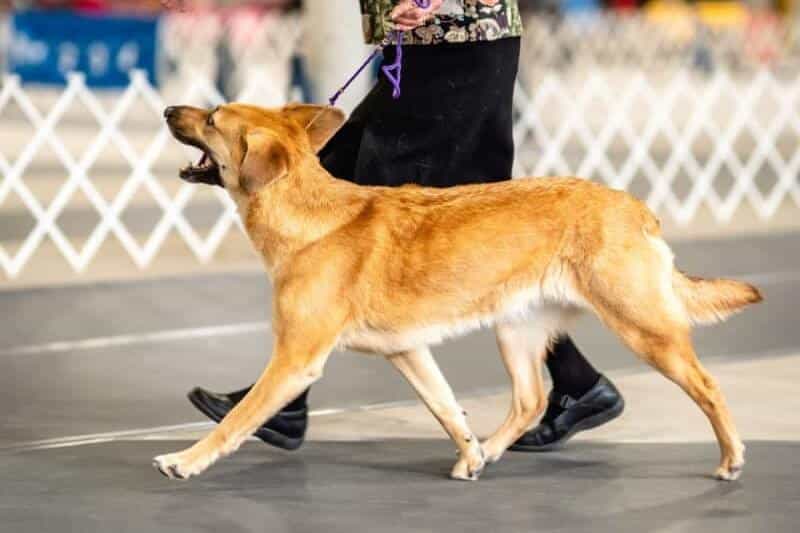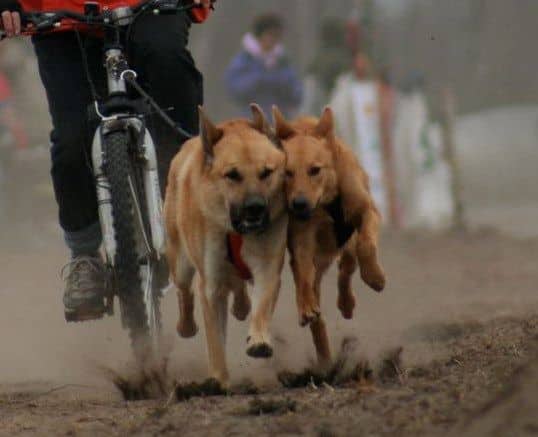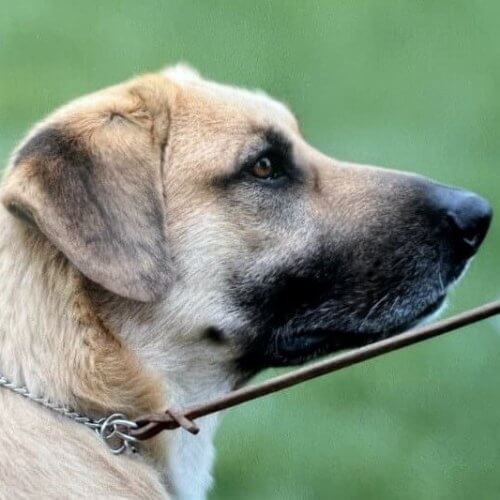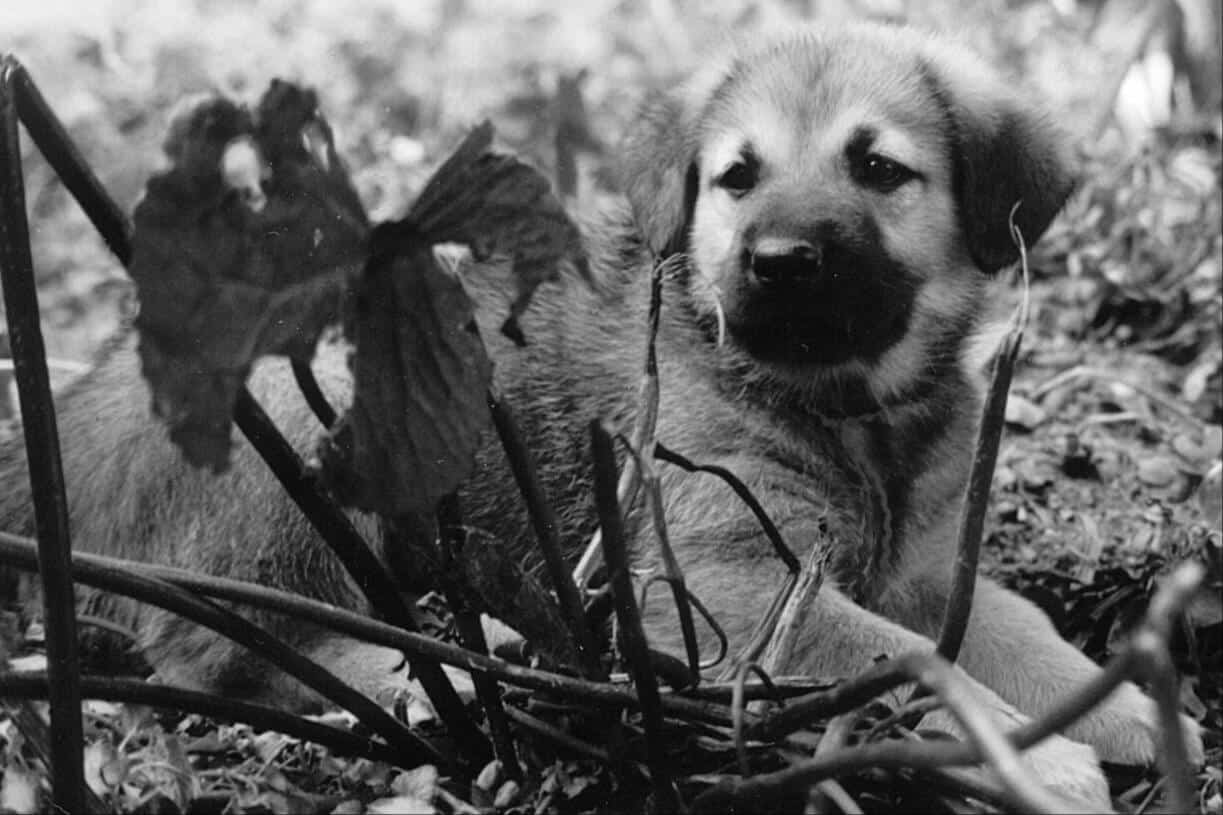
Judging Chinooks and the Breed Standard
Judging Chinooks: Learn the breed standard, from conformation and color to gait and temperament, and what makes this sled dog unique.

Home » Meet The Breeds » Chinook Dog Breed



The Chinook is a rare and versatile working dog known for its strength, endurance, and gentle temperament. Originally developed in the United States, the Chinook is a friendly and dependable companion, excelling in sledding, hiking, and other outdoor activities.
Working
22 – 26 inches
50 – 90 pounds
12 – 15 years
| Country of Origin | United States |
|---|---|
| Bred For | Drafting, Sled Dog Racing |
| Known For | Affection, Tawny Color, Black Eye Markings, Ear Carriages |
| Popularity | Low |
| Temperament | Affectionate, Devoted, Dignified, Playful |
| Activities | Hauling, Hiking, Sledding, Conformation Shows, Dog Sports |
The Chinook originated in the early 20th century in Wonalancet, New Hampshire, developed by Arthur Treadwell Walden. Walden sought to create a sled dog with a unique combination of strength, speed, and a gentle disposition. The foundation dog, named Chinook, was born in 1917 and was a cross between a Mastiff-type dog and a Greenland Husky. That dog’s offspring inherited his traits and became the foundation of the breed.
The breed quickly gained recognition as a capable sled dog, performing well in both recreational and competitive sledding. Chinooks accompanied Admiral Richard Byrd’s 1929 Antarctic expedition, solidifying the breed’s reputation as a strong and reliable working dog. Despite their many capabilities, however, the breed’s population dwindled after Walden’s death in 1947, with numbers reaching critically low levels by the 1980s.
Dedicated breeders worked tirelessly to save the breed from extinction, using the limited number of purebred dogs to rebuild the population. In 1991, the breed was recognized as the New Hampshire State Dog, a testament to its historical and cultural significance which has encouraged its continuation.
The American Kennel Club (AKC) officially recognized the Chinook as a member of the Working Group in 2013. Today, while still rare, they are cherished for their versatility, intelligence, and family-friendly temperament.
Male Chinooks typically stand between 24 and 27 inches tall at the shoulder, while females are slightly smaller, measuring 22 to 25 inches. In terms of weight, males range from 55 to 90 pounds, and females weigh between 50 and 65 pounds.
The Chinook has a balanced and athletic build, with its length slightly greater than its height, giving it a rectangular profile. The breed is muscular and substantial without appearing bulky, reflecting its history as a capable and enduring sled dog.
Texture: The Chinook’s double coat consists of a dense, soft undercoat and a coarse, medium-length outer coat. This combination provides protection against harsh weather conditions, reflecting the breed’s origins as a sled dog. The outer coat is straight, strong, and coarse, with longer hair on the ruff, shoulder blades, withers, breeches, and the underline. The tail is well-furred with feathering that starts four to five inches from the root.
| Standard Color | |
|---|---|
| Red Gold | n |
| Fawn | n |
| Tawny | n |
| Palomino | n |
| Gray Red | n |
| Silver Fawn | n |
| Buff | n |
| White | n |
| Black & Tan | n |
| Gray & Tan | n |
| Black | n |
| Standard Marking | |
|---|---|
| Black Mask | y |
| White Markings | y |
| Buff Markings | y |
A Note About Color: The tawny coat of the Chinook ranges from honey to a deep reddish-gold. Pigment of the muzzle, nose, lips, pads, and eye rims is black, although dilute tawny dogs may have dilute pigment. The color of the ears and muzzle is preferably darker. A black mark at and just above the inner corner of both eyes is desirable. Symmetrical white or cream to pale gold markings may appear on the cheeks, throat, chest, breeches, and underside. Any other white markings, including a blaze, socks, and scarves, are unacceptable.

The Chinook’s tail is an important feature of the breed’s natural appearance. It is moderately set, thick at the base, and tapers to a slight point. When at rest, the tail hangs naturally, but when in motion or alert it may curve upward in a gentle sickle shape. It does not, however, curl over the back. Consistent with the breed’s sled dog heritage, the tail is well-furred, providing protection against cold weather.
The Chinook is a rare and versatile breed, prized for its friendly nature, intelligence, and working ability. While these dogs are excellent family companions, their high energy levels and need for mental stimulation require a dedicated caretaker. Potential owners should be prepared to provide plenty of exercise, training, and companionship to keep this active and social breed happy.
Chinooks are generally healthy dogs with a lifespan of 12 to 15 years. However, like all dogs, they can be prone to certain health issues. Regular veterinary check-ups, a balanced diet, and an active lifestyle are essential to maintaining their well-being and longevity.
Chinooks can be predisposed to some health concerns, including:
Chinooks are known for their friendly, gentle, and intelligent nature, making them excellent companions for families and active individuals. They are social dogs that thrive on interaction with their human companions and do not do well when left alone for long periods.
Their sensitivity and eagerness to please make them highly trainable, but they also require positive reinforcement and patience. They are generally good with children and other dogs, displaying a calm and adaptable demeanor. While they are not naturally aggressive, they may be reserved with strangers but tend to warm up quickly with proper introductions.
Chinooks require a high-quality diet that meets their age, size, and activity level. Puppies benefit from a specially formulated puppy food to support their growth and development, typically fed in three to four small meals daily.
Adult Chinooks usually eat two meals per day, with portions adjusted to maintain a healthy weight. Most adult dogs require approximately 2 to 3 cups of food daily, depending on their activity level and metabolism. Fresh water should always be available, and treats should be given in moderation to prevent overfeeding. Consultation with a dog’s breeder and veterinarian can help to tailor a diet plan that suits any particular needs.
Chinooks are intelligent and eager to please, making them generally easy to train. They respond well to positive reinforcement methods, such as praise, treats, and play, which help to motivate and build trust.
Early socialization is essential to help them become well-rounded and confident dogs. Exposure to different environments, people, and other animals helps them develop a playful and affectionate temperament.
While they are not prone to excessive barking, Chinooks may alert their families to unfamiliar activity. Their working heritage means they enjoy tasks that engage both their mind and body, excelling in activities such as Obedience training, Agility, and Sled Dog Races. Patience and consistency are key to bringing out the best in this intelligent and sensitive breed.
Chinooks are active dogs that require daily exercise to stay physically and mentally healthy. They thrive on outdoor activities such as hiking, jogging, or long walks, and their history as a sled dog means they enjoy pulling or carrying light loads.
| Energy Level | Moderate |
|---|---|
| Exercise Requirements | 1 Hour/Day (Minimum), Daily Walks, Vigorous Running, Regular Exercise, Mental Stimulation |
Without sufficient exercise, they may become bored or restless, which can lead to undesirable behaviors. Mental stimulation, such as puzzle toys or training sessions, is just as important as physical activity. A securely fenced yard is ideal for off-leash play, but they should always be supervised.
Chinooks have a double coat that requires regular grooming to keep it in good condition. Weekly brushing helps to remove any loose hair and reduces shedding, especially during seasonal coat changes.
| Coat Type | Thick, Double, Straight, Strong, Coarse |
|---|---|
| Grooming Requirements | Weekly Brushing, Occasional Bathing, Routine Ear Cleaning, Periodic Nail Trimming, Regular Tooth Brushing |
They are typically moderate shedders but may require more frequent grooming during peak shedding seasons. They are generally clean dogs with minimal odor, so baths are only needed occasionally or when they become especially dirty. Regular nail trimming, ear cleaning, and dental care are essential for their overall health and hygiene.
Chinooks are adaptable dogs that are best suited to homes where they can receive plenty of attention and exercise. They can live in apartments, if given sufficient daily exercise, but are more comfortable in homes with access to a large yard.
Chinooks are social animals that bond closely with their families. Consequently, they may develop separation anxiety if left alone for extended periods. These dogs thrive in a home where they are included in family activities and given the opportunity to work or play regularly. Due to their dense double coat, they tolerate cold weather well but can struggle in high heat and humidity. Precautions should be taken throughout the year to ensure both safety and comfort.
Chinook puppies are energetic, curious, and eager to please, making them a joy to raise with the right guidance. Their intelligence and natural sociability require early training and socialization to help them grow into well-rounded adults with a desire to work.
This stage of life demands patience and consistency, as their high energy and playful nature can sometimes be overwhelming. A structured environment with plenty of positive reinforcement, mental stimulation, and gentle handling helps Chinook puppies thrive.
Caring for a Chinook puppy involves meeting the little one’s physical, emotional, and nutritional needs. A puppy should be fed a high-quality diet appropriate for its age, divided into three to four meals per day to support steady growth.
Age-appropriate exercise, such as short walks and supervised play, is important to prevent straining the developing joints. Socialization should begin early, exposing the pup to a variety of environments, people, and animals to foster both confidence and adaptability.
Providing a safe, loving, and structured environment is essential for puppy’s development. Positive reinforcement training helps to establish good behavior and strengthens the bond between puppy and caretaker. Likewise, routine veterinary visits, vaccinations, and preventive care will encourage overall good health as the puppy grows.
The Chinook is recognized by the world’s leading registries and kennel organizations, which categorize the breed into a specific Group based on its unique characteristics. This breed is recognized worldwide under the following Group designations:
| Organization | Group Designation |
|---|---|
| AKC (American Kennel Club) | Working |
| UKC (United Kennel Club) | Northern |
| CKC (Canadian Kennel Club) | Not Recognized |
| ANKC (Australian National Kennel Council) | Not Recognized |
| RKC (The Royal Kennel Club) | Not Recognized |
| FCI (Fédération Cynologique Internationale) | Not Recognized |
The ideal Chinook is described by a Breed Standard that is approved by each of the world’s leading registries and kennel organizations. The Breed Standards for this breed may be found in the following links:
| Organization | Breed Standard |
|---|---|
| American Kennel Club | AKC Chinook Breed Standard |
| United Kennel Club | UKC Chinook Breed Standard |
| Canadian Kennel Club | CKC Not Recognized |
| Australian National Kennel Council | ANKC Not Recognized |
| The Royal Kennel Club | RKC Not Recognized |
| Fédération Cynologique Internationale | FCI Not Recognized |
Chinooks are moderate shedders, with heavier shedding occurring during seasonal coat changes. Regular brushing helps to manage the shedding and keeps the double coat in good condition.
Chinooks are not considered hypoallergenic, as their shedding and dander can trigger allergies. While they are relatively clean dogs, they may not be suitable for individuals with severe pet allergies.
Chinooks typically have a lifespan of 12 to 15 years. Their longevity can be supported with proper care, a balanced diet, and regular veterinary check-ups.
Chinooks are excellent family dogs due to their friendly and gentle temperament. They are particularly good with children and thrive in homes where they receive plenty of companionship and activity.
Chinooks are not known for excessive barking but may vocalize to alert their human companions to unfamiliar situations. With proper training and attention, any barking can be well-managed.

Judging Chinooks: Learn the breed standard, from conformation and color to gait and temperament, and what makes this sled dog unique.
The best way to ensure a long and happy relationship with a purebred dog is to purchase one from a responsible breeder. Not sure where to begin?
Contact the National Parent Club’s Breeder Referral Program, which is listed on the AKC Breeder Referral Contacts page.
